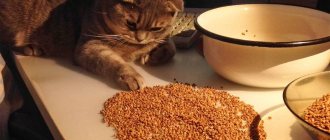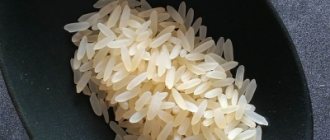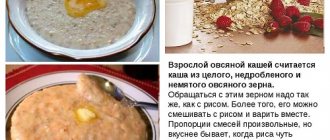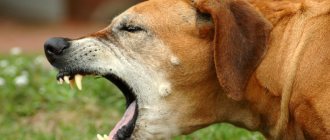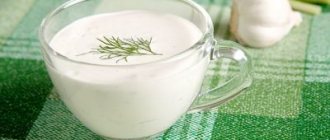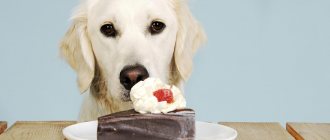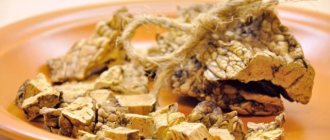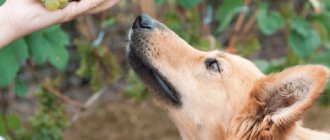Most dog breeders, being adherents of natural feeding for their four-legged pets, fundamentally refuse dry food. Sometimes, for example, in the case of a dog’s illness, experts consider it advisable to switch it to “natural” food.
In this regard, questions about what to feed a dog, which foods must be included in the diet, and which ones should be avoided, become relevant for pet owners. Porridge is one of the most popular dishes, but this does not mean that any cereal can be given to animals.
Buckwheat porridge
According to experts, buckwheat is for animals. It contains vitamins (A, B, E, H, PP), minerals (iron, calcium, zinc, magnesium, etc.), fiber, complex carbohydrates, amino acids.
Buckwheat saturates the body, fills it with vigor and energy.
The value of buckwheat lies in accelerating metabolism, stabilizing the cardiovascular system, strengthening the immune system and bone tissue. Thanks to its unique composition, buckwheat allows the body to rehabilitate faster in the postoperative period. Thanks to it, the dog does not gain weight, and also forgets about what allergies are.
Buckwheat porridge is considered the best option for a pet, but it must be prepared correctly. Here is the method recommended by veterinarians: pour 1 cup of buckwheat into 2 cups of boiling water. Cover the pan with a lid and wrap it in a blanket. Leave overnight. The next morning the porridge is ready to eat. Since most of the beneficial substances are lost during heat treatment, there is no need to cook the dish, nor do you need to add salt and pepper.
Nutrition rules
- Feeding should not extend throughout the day. It is necessary to put the plate of food in the refrigerator 15-20 minutes from the moment you offer your pet a meal.
- It is enough to feed the dog twice a day and in equal portions.
- You should purchase a plate stand for your pet. With its help, you can adjust the plates and place them opposite the dog’s chest.
- Don't overdo it with salt. It is present in every product in sufficient quantity for the dog. You can add a little if you are sure that the product is completely fresh.
- The dog should always have fresh water and in sufficient quantity.
- If one feeding was missed, no matter what the reasons, then the portion of food for the dog cannot be increased at the next meal. Feed the same amount as you usually give.
- If the dog carefully licks the plate, then most likely it is not full, and you should slightly increase the dose of food at the next feeding. You should not give a double portion, otherwise you will have to lose extra pounds.
- A dog's diet should be varied in order for the pet to be healthy and cheerful.
- You cannot feed your pet two hours before active exercise, and an hour before a regular walk. You should also not feed the animal an hour after physical activity.
- If dogs growl while eating, this is directly related to the wrong diet. It is necessary to set the exact time and amount of food and then the dog will stop growling, because it will intuitively know when it will be fed.
In order for your pet to be cheerful and healthy, feed him a balanced diet, walk him and pamper him with your attention, and he will not remain indifferent to you. Share your experience, how you feed your pet, how often you walk, and what your pet likes most.
Rice porridge
Rice is enriched with vitamins B, E, magnesium, calcium, zinc, iron, copper and other minerals, lipids. Cereals are a natural antioxidant and adsorbent and cleanse the body of toxins. That is why it is recommended for dogs that have previously been diagnosed with poisoning. In addition, it is endowed with astringent properties, so it is useful for animals with diarrhea.
Rice porridge gently envelops the stomach and reduces pain, so pets suffering from inflammatory processes in the digestive tract should definitely eat this dish.
However, rice also has contraindications. Due to its high starch content, it can be harmful to dogs with diabetes, obesity, and diarrhea. This does not mean that rice porridge is prohibited for such patients, it just needs to be given occasionally, to diversify the diet.
Preference should be given to unpolished rice, since it contains less starch than polished rice and more vegetable protein.
Method of preparation: rinse the cereal, soak it for an hour and a half in cold water. Soaking unpolished rice - 20 minutes. Boil. If the porridge turns out to be thick, you can add a little vegetable oil.
What to replace or supplement with?
Dogs digest buckwheat and rice porridge best; they are also allowed to offer oatmeal and, occasionally, semolina. It is best to give pearl barley in smaller quantities than rice and buckwheat.
Millet and wheat porridge can be a replacement option for it - they are not recommended for animals, but a number of dog breeders give them without problems.
Another option for pearl barley is mixing it with other cereals. But it is important to ensure that it is completely boiled, because its cooking time is longer than that of other cereals.
Oats
Oats and rolled oats should not be confused. Oats are whole grains, while rolled oats are flattened grains. However, both cereals are very useful for your pet. They contain vitamins A, B, E, PP, minerals (calcium, potassium, magnesium, sodium, etc.), vegetable proteins, amino acids, fats.
Diet porridge is an indispensable product for normalizing digestion after an illness accompanied by vomiting and diarrhea, or prolonged fasting. Gluten delicately envelops the intestines and walls of the digestive tract, and has a beneficial effect on the stomach and pancreas during inflammation. Oatmeal and jelly are always recommended by nutritionists for animals with gastritis and enteritis.
Do not forget: oatmeal can cause allergies and digestive upset. If you are giving oatmeal for the first time, add it in small quantities to the main dish to check whether it will become an allergen for your pet, and observe for a day. If your dog does not have an allergic reaction to oatmeal, include it in the diet, but do not overuse it.
It is advisable to give preference to oats other than oatmeal. It takes longer to cook, but it contains more nutrients. To prepare the grains, soak them in cold water for 2-3 hours, then boil them without adding salt. With soaking, the cereal will cook in 40-50 minutes.
How much to give?
Now that we have decided on the cereals, let’s calculate how much cereal to give the dog at one feeding? The main dish is porridge with meat products and vegetables, given to pets at the rate of 60-70 grams. feed per 1 kilogram of weight per day . This norm is divided into 2 or 3 doses.
A book about dogs (Roucerol Georges V.)
The proportions of the products are as follows: 50% stringy meat and offal; 30% porridge; 20% vegetables and fruits. Thus, per kilogram of dog weight, you need 30-35 grams of meat, 20-25 grams of porridge, and 5-10 grams of vegetables and herbs per day. A dog that weighs 15 kg should eat 150-190 grams with two meals a day. porridge for one feeding or 300-375 gr. in a day.
Semolina
Semolina, like millet, is an absolutely useless product for dogs. Semolina contains no useful substances, but a lot of simple carbohydrates.
However, the doctor may recommend it to premature newborn puppies to gain weight or to animals with gastrointestinal inflammation (for the period of treatment, so as not to burden the stomach and intestines).
Semolina is contraindicated for dogs that are overweight, prone to obesity, sedentary individuals and animals with diabetes (cereals contribute to an increase in blood sugar levels).
Other types of products
- Popcorn is absolutely useless food for dogs; a small amount of it will not cause significant harm, but can cause digestive upset.
- Corn flakes are dangerous, because the corn mass, before being fried and becoming flakes, is abundantly fertilized with various chemical additives that are completely undesirable for any animal.
- corn sticks also contain a lot of sugar; the dog’s body is not equipped to digest it, and therefore a strong allergic reaction is possible.
Barley porridge
Despite the fact that this cereal is very nutritious and enriched with vitamins, micro- and macroelements (fluorine, silicon), it is not suitable for daily use. The fact is that it is poorly absorbed by the body. Nevertheless, it must be given. For it to really bring benefits, it is better to mix it with other porridges, for example, with buckwheat.
Tip: feed your pet only freshly cooked porridge, after cooling it to room temperature. A cold dish turns into an unappetizing mess and is not absorbed by the body.
How and what cereals are cooked for dogs
We can conclude that the most preferable cereals for use in a dog’s diet are: buckwheat, rice, oatmeal, wheat and barley.
Porridges for feeding pets can be prepared from one type of cereal, or “combined” from several: they will have great nutritional value and excellent taste. You shouldn’t change grains in your dog’s diet frequently, as this can cause indigestion. It is better to choose some basic grain and add other grains little by little, changing them from time to time. It is not recommended to prepare viscous porridges so as not to harm the animal’s intestines. Loose porridges are preferable because they are easier to digest. Don’t forget that cereals should make up no more than 30% of your pet’s diet, so porridges must be prepared with various meat additives.
Corn porridge
Regarding whether it is possible to give a dog corn porridge, veterinarians agree: no, it is not! Just like millet and semolina, corn is completely useless for animals. Undoubtedly, it quenches the appetite well and gives a feeling of satiety, but it does not provide any nutritional value. But it's not only that.
Porridge passes through the gastrointestinal tract very difficultly, forms clumps and is poorly digested. In dogs that lead an active lifestyle, it can cause volvulus, a dangerous pathology. Under no circumstances should you give corn porridge to animals experiencing digestive problems, otherwise exacerbations cannot be avoided.
It is much more useful to offer the dog to chew on a fresh corn cob, but you need to make sure that he does not get carried away and get to the core. Don't be alarmed if the grains come out undigested in your feces.
Harm from excess carbohydrates
A dog's diet requires careful selection of foods and maintaining a balance between weight and energy value. Easily digestible carbohydrates, which enter the body in excess with corn porridge, remain unspent and are converted into fat reserves, and also inhibit the intestinal microflora , triggering the processes of fermentation and putrefaction. This is how the dog develops dysbiosis.
The condition of the intestine, which is the leading organ not only in the digestive system, but also in the immune system, directly affects the overall health of the pet .
Dysbiosis in the intestines, which is caused by dietary disturbances, can cause the development of a host of secondary health problems , such as a tendency to allergies, disruption of internal organs, the occurrence of a number of chronic inflammatory diseases and obesity, often associated with each other.
Dysbacteriosis also aggravates the course of many concomitant diseases, significantly exacerbating them. Symptoms of dog intestinal dysbiosis:
- vomit;
- diarrhea;
- bloating;
- lethargy;
- loss of appetite;
- irritable bowel syndrome.
What to add to porridge
As mentioned above, salt and spices should not be added to porridge. And excess fats will not be beneficial for your pet. However, you won’t be satisfied with porridge alone, so add meat and vegetables to it.
Vegetables are rich in fiber, which is beneficial for intestinal motility. Carrots, beets, rutabaga, pumpkin, and zucchini are most suitable for this purpose. You can give broccoli, cauliflower, and potatoes with caution. But you can’t give onions and garlic.
As for meat, the ideal option is turkey and rabbit, veal, horse meat. These are lean meats that will not harm the liver and are hypoallergenic.
Pork and lamb are too fatty, so they should be excluded from the menu.
Chicken is a dietary product, but it can cause allergies. Meat products must be subjected to heat treatment; frozen meat is also allowed.
By-products are very useful. The liver is a source of vitamins and micro- and macroelements; the heart, rumen, and lungs are good in this regard. They should be included in the diet boiled, as offal can be contaminated with helminths.
Sample diet for dogs
A well-designed menu for a pet is the key to its excellent health and good mood. Therefore, it is important to know what and in what proportions it is recommended to include in a dog’s diet:
- Meat and offal
are the main components of the daily dog menu. The share of meat products in the total daily feed volume should be at least 50%. - fish fillet
no more than twice a week. You should choose low-fat varieties of sea fish, since river fish carries the risk of helminthiases and is too bony. It is better not to offer fish raw, but definitely boil it. - A variety of vegetables
acceptable for feeding dogs should make up approximately 10-20% of the main daily food volume. They provide animals with vitamins and fiber. - Cereals
recommended for a dog’s diet should make up at least 30% of the total daily food volume and be offered in the form of crumbly porridges with meat and vegetable additives. - Fermented milk products
in an amount of approximately 10% must be included in a dog’s diet. They are useful as a source of calcium and help normalize intestinal microflora.
Regular whole milk, homemade or processed, is not recommended for pets. Fermented milk products should not have high fat content, contain sugar or flavoring additives. The following are definitely suitable for dogs: kefir, fermented baked milk, yogurt, white yogurt, cottage cheese.
Knowing how to properly organize a balanced diet for your dog, you can create a diet that fully meets the daily energy needs of your pet’s body. Which, in turn, guarantees the normal development of the dog, prevents diseases, and strengthens the overall health of the pet.
Do you like the article? 235
Wheat
“Can dogs have wheat porridge?”
the answer is ambiguous, it is rich in vitamins C, E, A, B, phosphorus, calcium, but is inferior to the others. Not all owners use wheat cereal, because it is less digestible, so giving such a dish to a dog is risky. It should not be given to a puppy or small breed dogs. Large ones may rarely feed on it. It is necessary to cook the wheat until smooth, about 1 hour. Whether it is logical to give wheat to dogs is up to the owner to decide. There is no clear answer as to whether a dog can have wheat porridge; it is better to choose small portions and monitor the reaction.
